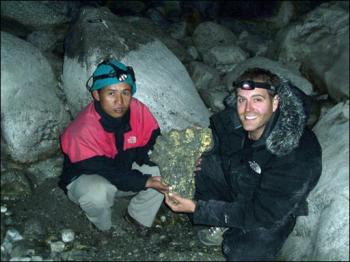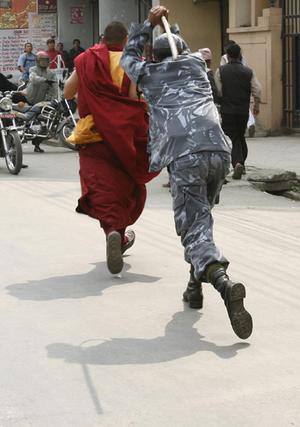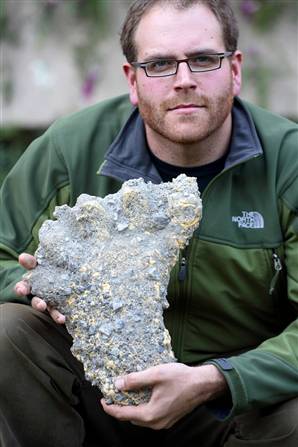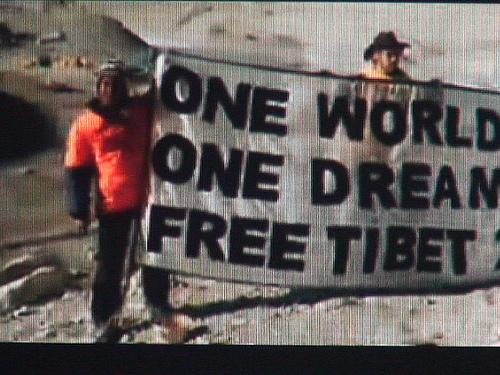
March 22, 2008
Three images:

A documentary film crew finds Yeti tracks in Nepal, December 2007.

A monk is beaten in Kathmandu amid protests by Tibetan refugees in Nepal, March 2008.

Chinese troops kill Tibetans in the most violent protests in Tibet in 20 years, March 2008.
In a region of the world where the Chinese killing of Tibetans has been in the news all week, it seems strange to read the travel article in today’s New York Times.
Entitled “As Turmoil Subsides, Tourism in Nepal Surges,” it allegedly heralds the return of visitors to a nation raked by its own bloodshed in the last decade. Perhaps it also signals something to all of us about the importance of a Free Tibet.
The entry point for reporter Seth Sherwood of the New York Times is our old friend, the Yeti:
As morning crowds of sari-clad women and mustached men packed the busy streets of Katmandu on the first day of December, The Himalayan Times, an English-language daily newspaper, trumpeted a staggering discovery.
“Yeti Footprints Found at Khumbu,” declared the headline in bold type. An article explained that an expedition had come across a mammoth five-toed footprint buried in the ice near the base camp for Mount Everest. After a long period without a credible sighting, the elusive creature seemed to have suddenly reappeared.
In fact, it was hardly the only reappearance to celebrate. All over Katmandu that week, from trekking agencies to curry houses, some almost equally prized specimens were leaving tracks after years of scarcity: foreign travelers. According to the Nepal Tourism Board, December capped a banner year, with air arrivals up 27 percent over the 2006 total. Overall, 2007 welcomed some 360,000 foreign air travelers to the country, making it the most successful year for tourism since 2000.
Later, while talking to an American tourist, Sherwood writes:
“We had planned to come a couple of years ago, but the political unrest made it impossible,” said Christa Hoyal, from Utah, as she lunched at the Katmandu Guest House with her traveling companion, Liz Tanner, also from Utah. A copy of The Himalayan Times with the yeti article on the front lay next to them. “But when things settled down,” she said, “we rebooked our tickets and came over.”
So far, Ms. Hoyal said, they had ridden elephants on safari in Royal Chitwan National Park and explored Katmandu’s centuries-old Hindu shrines and former royal palaces.
“There have been no concerns at all in terms of personal safety,” she said.
For others who have canceled or deferred journeys to Katmandu, the good news is that the troubled decade did nothing to harm the city’s age-old appeals.

Josh Gates is shown above with the Yeti footprint cast, dated December 1, 2007, from his Nepal expedition.
It turns out the “Destination Truth” film crew’s innocent trek into Nepal and discovery of Yeti prints may have had a greater impact and deeper meaning than even they realized.

A banner unfurled on Mt. Everest.
The world is not all about elephant safari rides, however. Some freedoms must be won first.
Could the return of the Yeti serve as a prophetic sign of another change returning to the region?
Indeed, could the freeing of Tibet be far behind?
I, for one, certainly hope, and with the Tibetans, pray so.

About Loren Coleman
Loren Coleman is one of the world’s leading cryptozoologists, some say “the” leading living cryptozoologist. Certainly, he is acknowledged as the current living American researcher and writer who has most popularized cryptozoology in the late 20th and early 21st centuries.
Starting his fieldwork and investigations in 1960, after traveling and trekking extensively in pursuit of cryptozoological mysteries, Coleman began writing to share his experiences in 1969. An honorary member of Ivan T. Sanderson’s Society for the Investigation of the Unexplained in the 1970s, Coleman has been bestowed with similar honorary memberships of the North Idaho College Cryptozoology Club in 1983, and in subsequent years, that of the British Columbia Scientific Cryptozoology Club, CryptoSafari International, and other international organizations. He was also a Life Member and Benefactor of the International Society of Cryptozoology (now-defunct).
Loren Coleman’s daily blog, as a member of the Cryptomundo Team, served as an ongoing avenue of communication for the ever-growing body of cryptozoo news from 2005 through 2013. He returned as an infrequent contributor beginning Halloween week of 2015.
Coleman is the founder in 2003, and current director of the International Cryptozoology Museum in Portland, Maine.
Filed under Abominable Snowman, Breaking News, Conspiracies, Cryptotourism, CryptoZoo News, Cryptozoologists, Cryptozoology, Destination Truth, Expedition Reports, Footprint Evidence, Media Appearances, Photos, Pop Culture, Twilight Language, Yeti